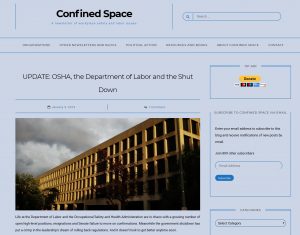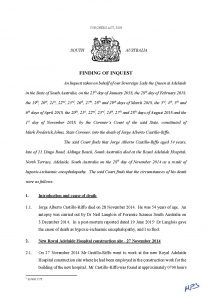Several readers have raised their eyebrows over recent media reports in South Australia that say that SafeWorkSA is in the process of accepting an Enforceable Undertaking (EU) related to the death of 54-year-old Debra Summers, who was found dead in a freezer at the Echunga police training reserve on October 4, 2016. The use of EUs when a fatality is involved deserves discussion and resolution, especially when the workplace death involves a hazard that was so well-known.
Category: Investigation
Jordan Barab provides important OHS insights
 I learnt more about the politics of the United States from Doonesbury than I did from television news and analysis. I learn more about the politics of occupational health and safety (OHS) in the United States from Jordan Barab‘s Confined Space newsletter/blog than I do any other media source. Although the US’s OHS legal structures are different from Australia and other Commonwealth countries, the political ideologies and maneuverings, and fads and statistics are noted by political parties outside the United States.
I learnt more about the politics of the United States from Doonesbury than I did from television news and analysis. I learn more about the politics of occupational health and safety (OHS) in the United States from Jordan Barab‘s Confined Space newsletter/blog than I do any other media source. Although the US’s OHS legal structures are different from Australia and other Commonwealth countries, the political ideologies and maneuverings, and fads and statistics are noted by political parties outside the United States.
Recently Barab posted a Year in Review article which is obligatory reading. His key issues included:
- A New and Improved Congress (or at least the House)
- A Headless Agency
- Inspectors down, enforcement units down, penalties down
- Return of Black Lung
- Brett Kavanaugh
- Regulatory Rollback
- The Fate of the Labor Movement
Anything sound familiar in your own jurisdiction?
OHS is often about broken promises
 Occupational health and safety (OHS) is often about promises. Employees trust their bosses to provide them with a job and the employer promises to provide a workplace that is as safe as possible. There are also contractual policies which formalise OHS relationships between client and contractor. But OHS is more often about those more personal promises and expectations between the boss and the worker.
Occupational health and safety (OHS) is often about promises. Employees trust their bosses to provide them with a job and the employer promises to provide a workplace that is as safe as possible. There are also contractual policies which formalise OHS relationships between client and contractor. But OHS is more often about those more personal promises and expectations between the boss and the worker.
A
Timeline for PC Mental Health Inquiry
 One of the Commissioners of Australia’s Productivity Commission (PC), Julie Abramson, spoke briefly at a lunchtime seminar on Mental Health and the Economy, hosted by the Committee for Economic Development of Australia. It is very early in the PC’s inquiry into the role of improving mental health but Abramson was able to provide some draft timelines.
One of the Commissioners of Australia’s Productivity Commission (PC), Julie Abramson, spoke briefly at a lunchtime seminar on Mental Health and the Economy, hosted by the Committee for Economic Development of Australia. It is very early in the PC’s inquiry into the role of improving mental health but Abramson was able to provide some draft timelines.
Abramson told the audience that the Presiding Commissioner on this inquiry
Productivity Commission sets stage for inquiry into mental health
 The Australian Government has released the terms of reference into its Productivity Commission inquiry into mental health. The inquiry has broad aims that clearly include occupational health and safety (OHS) and may set some evidence challenges for some of those in the workplace wellbeing sector:
The Australian Government has released the terms of reference into its Productivity Commission inquiry into mental health. The inquiry has broad aims that clearly include occupational health and safety (OHS) and may set some evidence challenges for some of those in the workplace wellbeing sector:
“It will look at how governments across Australia, employers, professional and community groups in healthcare, education, employment, social services, housing and justice can contribute to improving mental health for people of all ages and cultural backgrounds.” (emphasis added)
The Treasurer Josh Frydenberg MP has written that
“the Commission should consider the role of mental health in supporting economic participation, enhancing productivity and economic growth.”
Many safety lessons from one workplace death
 The Coronial Finding in to the death of Jorge Castillo-Riffo is an important occupational health and safety (OHS) document. It discusses, amongst other matters,
The Coronial Finding in to the death of Jorge Castillo-Riffo is an important occupational health and safety (OHS) document. It discusses, amongst other matters,
- A curious attitude from SafeWorkSA
- The role of Safe Work Method Statements and risk assessments
- Using the right plant for the right task
- Contractual relationships
- Construction methodology.
More issues than these are raised in the Finding and I urge all OHS people to read the document and reflect on the OHS management in their workplaces.
Scissor Lift death findings clarify the context of OHS
 If all you knew about occupational health and safety (OHS) was what you read in the physical or online newspapers , you would not know anything about safety management – or maybe anything positive. It takes being involved with managing safety in the real world to understand how OHS operates in the real world. But even then we only learn from our own experiences.
If all you knew about occupational health and safety (OHS) was what you read in the physical or online newspapers , you would not know anything about safety management – or maybe anything positive. It takes being involved with managing safety in the real world to understand how OHS operates in the real world. But even then we only learn from our own experiences.
The 92-page coronial finding into the death of Jorge Castello-Riffo, released last week, is a tragic and detailed case study of OHS in the real world and should be obligatory reading for OHS professionals and those trying to understand the push for increased OHS, penalties and corporate accountability. Below I look at just one section of the Coronial Findings in this article – the Coroner’s responses to a set of proposed recommendations.
